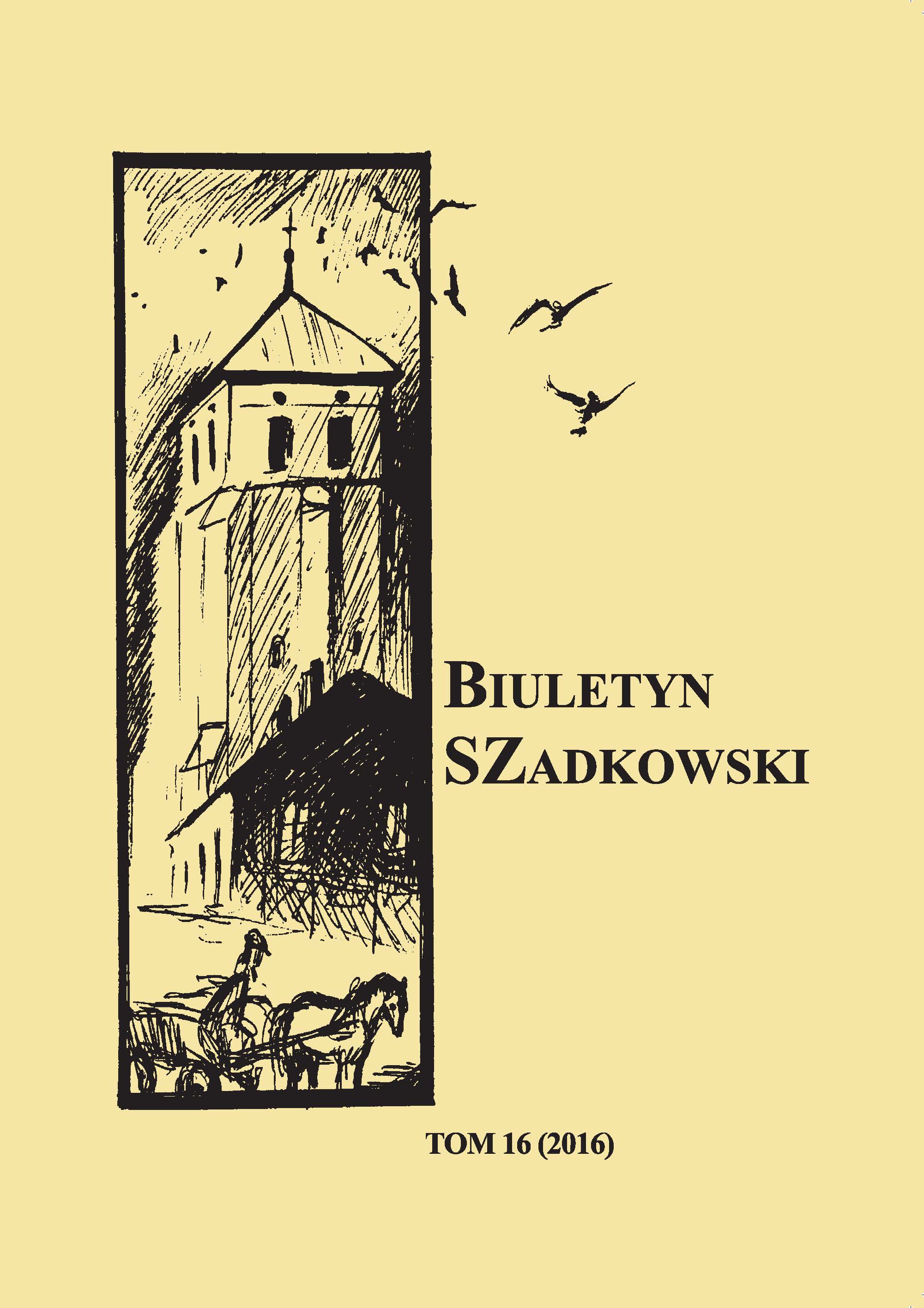Flower Ivy Hedera helix in the forests surrounding Szadek
DOI:
https://doi.org/10.18778/1643-0700.16.17Keywords:
Hedera helix, blossoming, climate change, forest fragmentationAbstract
In 9 sites of Hedera helix occurrence were recorded in the forests surrounding area Szadek. The species grows mainly on the fresh-mixed and – fresh forest site types. 195 flowering and fruiting specimens were found. The most frequent support for Hedera helix offer such tree species as black alder Alnus glutinosa, common oak Quercus robur and Scots pine Pinus sylvestris. Flowering specimens of the climber are found growing at forest edges, in degraded communities of mixed linden-oak- and -riparian forests as well as in the fringes of gaps in forest stands under reconstruction. The dispersal of Hedera helix in forests is attributed to both the rise in annual average temperatures and, in particular, higher average temperatures in winter months, and to the fragmentation of forest.
References
Ackerfield J., Wen J., Evolution of Hedera (The ivy genus, Araliaceae): insights from chloroplast DNA data, “International Journal of Plant Science” 2003, 164 (4).
Google Scholar
Atlas rozmieszczenia roślin naczyniowych w Polsce, red. Zając A., Zając M., nakładem Pracowni Chorologii Komputerowej Instytutu Botaniki Uniwersytetu Jagiellońskiego, Kraków 2001.
Google Scholar
Boratyńska K., Kwitnące i owocujące okazy Hedera helix L. w Polsce, Arboretum Kórnickie 1987, 32.
Google Scholar
Borowicz K., Gostyńska-Jakuszewska M., Atlas rozmieszczenia drzew i krzewów w Polsce 8, 1967.
Google Scholar
Bożek A., Naturalne stanowiska owocującego bluszczu Hedera helix L. w Jurze Krakowsko-Częstochowskiej, „Chrońmy Przyrodę Ojczystą” 1979, 35 (6).
Google Scholar
Bugała W., Drzewa i krzewy dla terenów zieleni, Państwowe Wydawnictwo Rolnicze i Leśne, Warszawa 1991.
Google Scholar
Derr J.F., English ivy (Hedera helix) response to postemergence herbicide, “Journal of Environmental Horticulture” 1993, 11.
Google Scholar
Ellenberg H., Vegetation Ecology of Central Europe, Cambridge University Press, Cambridge 1988.
Google Scholar
Fortuniak K., Kożuchowski K., Papiernik Ż., Roczny rytm termiczny klimatu Polski i jego sezonowe osobliwości, „Przegląd Geograficzny” 1998, 70 (3–4).
Google Scholar
Granoszewski W., Krupiński K.M., Nita M., Nalepka D., Hedera helix L. – Ivy, [w:] Late Glacial and Holocene History of Vegetation in Poland Based on Isopollen Maps, red. M. Ralska-Jasiewiczowa, M. Latałowa, K. Wasylikowa, K. Tobolski, E. Madeyska, H.E. Wright Jr., Ch. Turner, W. Szafer Institute of Botany, PAS, Kraków 2004.
Google Scholar
Jakubowska-Gabara J., Nowe stanowiska kwitnącego bluszczu Hedera helix w Polsce Środkowej, „Chrońmy Przyrodę Ojczystą” 1988, 4 (2).
Google Scholar
Jones C.C., Acker S.A., Halpern C.B., Combining local- and large-scale models to predict the distributions of invasive plant species, “Ecological Applications” 2010, 20 (2).
Google Scholar
Kożuchowski K., Żmudzka E., Ocieplenie w Polsce: skala i rozkład sezonowy zmian temperatury powietrza w drugiej połowie XX wieku, „Przegląd Geofizyczny” 2001, 1–2.
Google Scholar
Kucharski L., Prawna ochrona roślin w Polsce w latach 1947–2011, „Acta Botanica Silesiaca” 2014, 10.
Google Scholar
Kucharski L., Kloss M., Rozprzestrzenianie się bluszczu pospolitego Hedera helix L. w lasach środkowej Polski, mpis, Zakład Ochrony Przyrody UŁ, Łódź 2015.
Google Scholar
Londré R.A., Schnitzer S.A., The distribution of lianas and their change in abundance in temperate forests over the past 45 years, “Ecology” 2006, 87 (12).
Google Scholar
Metcalfe D.J., Biological Flora of the British Isles: Hedera helix L., “Journal of Ecology” 2005, 93.
Google Scholar
Navasaitis M., Paprastosios gabenés (Hedera helix L.) biologijos Lietuvoje klausimu, “Dendrologia Lithuaniae” 1995, 94.
Google Scholar
Obidziński A., Paluszek D., Długołęcki W., Kuberski Ł., Ekspansja obcych gatunków roślin drzewiastych z Arboretum SGGW w Rogowie, „Rocznik Dendrologiczny” 2003, 51.
Google Scholar
Olaczek R., Owocujący bluszcz pospolity Hedera helix w Polsce Środkowej, „Chrońmy Przyrodę Ojczystą” 1979, 35 (5).
Google Scholar
Papiernik Ż., Klimat, [w:] Pradolina Bzury – Neru. Monografia przyrodnicza obszaru Natura 2000, red. L. Kucharski, D. Kopeć, Towarzystwo Przyrodników Ziemi Łódzkiej, Łódź 2014, s. 21–25.
Google Scholar
Reichard S., Hedera helix L. English Ivy, Invasive Plants of California’s Wildlands, 2000.
Google Scholar
Rozporządzenie Ministra Środowiska z dnia 9 października 2014 r. w sprawie ochrony gatunkowej roślin, Dz.U. z 16 października 2014, poz. 1409.
Google Scholar
Skrzypski J., Papiernik Ż., Zmiany bioklimatu miast, Wydawnictwo Naukowe PAN, Warszawa 2006.
Google Scholar
Thomas L.K., Topographic alterations, forest structure, and invasion by English Ivy (Hedera helix L.) in the Rock Creek Floodplain, Washington, D.C., “Natural Areas Journal” 1998, 18 (2).
Google Scholar
Trąba C., Wolański P., Rogut K., Studium etnobotaniczne. Znaczenie roślin w kulturze, tradycji i życiu człowieka, Stowarzyszenie na Rzecz Rozwoju i Promocji Podkarpacia PRO CARPATHIA, Rzeszów 2014.
Google Scholar
Tutin T.G., Heywood V.H., Burges N.A., Moore D.M., Valentine D.H., Walters S.M., Weeb D.A., “Flora Europaea”, Vol. 2, Cambridge University Press, Cambridge, New York, Port Chester, Melbourne, Sydney 1990.
Google Scholar
Westbrook R., Invasive Plants: Weeds of the Global Garden, Brooklyn Botanical Garden, Brooklyn, New York 1998.
Google Scholar
Woziwoda B., Flora Lasu Szadkowskiego, „Biuletyn Szadkowski” 2007, t. 7.
Google Scholar
Woziwoda B., Szczerkowska-Majchrzak E., Charakterystyka geobotaniczna rzeki Pichna Szadkowska na odcinku od źródła w Zimnej Wodzie do ujścia z terenu uroczyska Wojsławice, „Biuletyn Szadkowski” 2014, t. 14.
Google Scholar
Downloads
Published
How to Cite
Issue
Section
License

This work is licensed under a Creative Commons Attribution-NonCommercial-NoDerivatives 4.0 International License.









